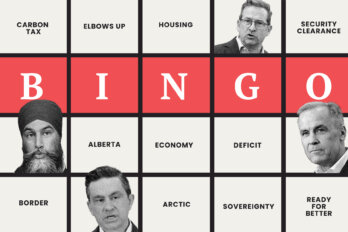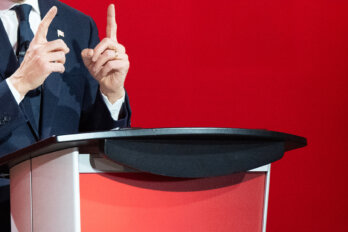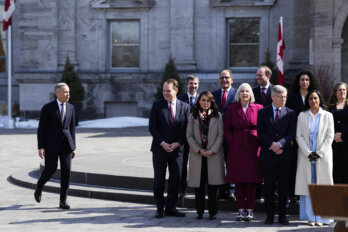Listen to an audio version of this story
For more audio from The Walrus, subscribe to AMI-audio podcasts on iTunes.
In early February, when public safety minister Bill Blair announced that the Proud Boys would be added to Canada’s list of terrorist entities, he offered no evidence to justify the decision. He didn’t need to. Unlike the legal criminal standard of “proof beyond a reasonable doubt,” the minister required only “reasonable grounds to believe” that the Proud Boys were implicated in terrorist activity.
Listen to an audio version of this story
For more audio from The Walrus, subscribe to AMI-audio podcasts on iTunes.
The terror listing capped the striking ascent of the Proud Boys as an ultraconservative fraternity—the obvious flip side of the “how to be an antiracist” left. Self-described Western chauvinists, they began in 2016 as a lark, a men’s drinking club whose early meetings in New York City, according to founder Gavin McInnes, a fifty-year-old far-right provocateur, involved “a dive bar and then a trip to the tattoo shop.” Four years later, according to Forbes magazine, the group had 50,000 followers on Parler, the social media platform favoured by conservatives and conspiracy theorists. (They have been banned from Facebook, Instagram, and Twitter.) In their distinctive black-and-yellow Fred Perry polos, the group had become, in the eyes of many, the poster boys for white supremacy.
The government’s decision, covered around the world, won hosannas from many quarters. The listing allows the group’s assets to be frozen or seized, and according to online national-security forum Just Security, it also assigns investigation of the Proud Boys to the Canadian Security Intelligence Service (CSIS). A former State Department official called for the US to consider a similar designation, while a petition imploring president Joe Biden to declare the group a terrorist outfit has garnered over 500,000 signatures. No surprise there. Nothing can absolve the Proud Boys of their noxious behaviour in recent years. In 2017, five members of the group (who also happened to be Canadian Forces personnel) made national news by crashing an Indigenous ceremony in Halifax on Canada Day. That August, a white supremacist affiliated with the group helped organize the “Unite the Right” rally in Charlottesville, Virginia, where Heather Heyer was mowed down with a car and killed. Proud Boys have brawled with left-wing and Black Lives Matter demonstrators in Portland, Oregon; Berkeley, California; and Washington, DC, among many other cities. Enrique Tarrio, their current leader, was recently arrested for allegedly ripping a BLM banner from a United Methodist Church and setting the banner ablaze.
Their thuggishness may qualify them as a “hate group” (so says the Southern Poverty Law Center) or as “a strain of American right-wing extremism” (so says the Anti-Defamation League). They may hold misogynistic, Islamophobic, antisemitic, anti-immigrant, and white supremacist views. Some may be violent criminals. But do their actions warrant the label of terrorist entity?
Terrorism is a bit like pornography: hard to define, easy to recognize. The government’s list provides a sickening catalogue of indisputably terroristic violence. Since 2015, the Islamic State alone has coordinated six attacks in Paris (killing 120), bombings in Brussels (killing thirty-one), the Manchester Arena suicide bombing (killing twenty-two), and vehicular rammings in the UK and Spain (killing at least twenty-seven). Boko Haram kidnapped 276 schoolgirls in 2014, uses children as suicide bombers, and racked up approximately 850 deaths in 2017. The list includes dozens of these murderous outfits, many of which you’ve probably never heard of. Hay’at Tahrir al-Sham, an Islamist faction in Syria, has claimed responsibility for nearly 600 attacks, while the Basque separatist group Euskadi Ta Askatasuna has killed over 800 people in 1,600 terrorist attacks.
The list makes for numbingly repetitive reading. The causes differ, but the tactics are largely the same: mass-casualty bombings, hijackings, hostage takings, improvised explosive devices, guerilla-style ambushes, truck bombs, knife attacks, assassinations, kidnappings for ransom, and videotaped beheadings. Many of these groups organize paramilitary training camps. They stockpile weapons. They take credit for attacks they planned and sometimes for those they didn’t. In their wake, victims do not sit and debate whether these groups are real terrorists.
As far as we know, the Proud Boys haven’t engaged in these familiar terrorist tactics—they haven’t been so much as charged with a single terrorist offence in Canada. Of course, it’s conceivable the group was planning such an attack. But Blair, when pressed, would not clarify whether the decision to label Proud Boys as special enemies of the state was based on publicly available information, secret intelligence on disrupted plots, or ongoing investigations. Whether the Proud Boys had been listed on the basis of state secrets was itself a state secret. Blair spoke of a “trove” of information, insisting that the decision had come via a neutral consideration of “evidence, intelligence, and the law.” He spoke of the group’s “escalation toward violence.”
But the listing may also have made it significantly easier to get into the club. Amarnath Amarasingam, a terrorism scholar at Queen’s University, called the decision “mostly political.” Amarasingam has no love for the Proud Boys and appreciates that the designation will make it harder for the group to openly recruit and fundraise. But, while seeing the upside, Amarasingam suspects politicians were, in part, swayed by their own ideology. “This ‘feel-good’ approach to terrorism labelling is not a great strategy. I know it temporarily feels like justice, but lowering the threshold to include groups like the Proud Boys could backfire.”
What he means is that the “good optics” of applying enhanced surveillance and law enforcement power against a right-wing extremist group like the Proud Boys today could make it easier to deploy that same security apparatus against “left-wing extremist” groups—including Indigenous and Black Lives Matter protesters—tomorrow. Conservative leader Erin O’Toole has already signalled a willingness to go in this direction. In a tweet last February addressing rail blockades near Tyendinaga Mohawk Territory, O’Toole, then a leadership candidate, argued that the protesters “crossed the line from illegal protest to terrorism.”
After four years of encouragement by Donald Trump, the far right is more dangerous than ever. This danger is not rhetorical. The Base distributes manuals for bomb-making and lone-wolf attacks, while Atomwaffen Division provides weapons and combat training in preparation for racial warfare and the collapse of society. The risk posed by actual terrorists calls for a serious, coherent response, and we can hope that the Canada Centre for Community Engagement and Prevention of Violence, the agency responsible for counter-radicalization strategy, is working on such a response. By contrast, Justin Trudeau’s government’s “feel-good” listing of the Proud Boys as a terrorist entity should not be mistaken for anything other than empty political grandstanding in the aftermath of an American tragedy.
Their name comes from a song from Disney’s Aladdin in which the eponymous street urchin vows to “get over these lousin’ up, / messin’ up, screwin’ up times” to finally make his ma “proud of your boy.” From the start, McInnes insisted his boys were inclusive, not racist or antisemitic. Men of all ethnicities could join—so long as they embraced that “the West is the Best.” Yet McInnes had long identified the white race as a specific source of pride. “I love being white and I think it’s something to be very proud of,” he told the New York Times back in 2003. “I don’t want our culture diluted. We need to close the borders now and let everyone assimilate to a Western, white, English-speaking way of life.” Today, the most basic tenet of the Proud Boys is that they “refuse to apologize for creating the modern world.”
McInnes’s previous venture, Montreal- and then Brooklyn-based Vice magazine, helped define the hipster aesthetic of the aughts. If the McInnes-era druggy, scatological, quasi-pornographic Vice celebrated decadence, then the Proud Boys swerved in the opposite direction, promising the restoration of a retro vision of order. (“Venerating the housewife” is part of their platform.) Prospective Proud Boys can face at least three “degrees” of initiation. These include publicly declaring allegiance to the group, even at the cost of social ostracization or your job, and a hazing ritual in which applicants have the “crap beaten out of them by at least five guys” until they sputter out the names of five breakfast cereals. Clad in his white shirt, thick-rimmed glasses, and pocket-protector, McInnes would speak of the long-running “war on masculinity.” A green frog, the “okay” hand gesture—McInnes did not invent the semiotics of the far right, but he knew better than most how to use them. Chapters sprang up not only across the United States and Canada but around the globe.
McInnes officially quit the group in 2018, on the advice of his lawyers, after a New York City street brawl resulted in criminal charges for ten of his compatriots. Still, in listing the Proud Boys as a terrorist entity, the Canadian government was in some ways piggybacking on McInnes’s marketing savvy. After a summer of protests across the US and the January 6 attack on the Capitol, the government seemed eager to prove that it was serious about far-right extremism. McInnes had provided it with an instantly recognizable brand with which to score political points.
The government’s instinct for good symbolism may have pushed the Proud Boys to the head of the terror line, ahead of more odious organizations capable of perpetuating actual terror. Consider the Order of Nine Angles, a Nazi Satanist organization that has featured in numerous recent UK terrorism prosecutions. The Azov Battalion, a white-supremacist militia, recruits members from around the world and provides combat training and experience fighting Russian forces in Ukraine. These groups may be more dangerous than the Proud Boys, but they are also less well known in Canada and less politically expedient for the government to single out.
The government’s most concrete rationale for the decision is what the listing calls the Proud Boys’ “pivotal” role in the US Capitol attack. The New York Times reports that prosecutors have brought four separate cases against six individual Proud Boys, suggesting that the group brought “some coordination” to the attack. As Leah West, former national-security lawyer at the Department of Justice, observes, it is “unusual” for the government to leapfrog a judicial process that has not yet resulted in a conviction. Meanwhile, a Chicago Project on Security and Threats analysis of 193 resulting arrests found that just “20 of the Capitol arrestees we studied—one-tenth—can be classified as supporters of gangs, militias, or militia-like groups such as the Proud Boys, Oath Keepers, and Three Percenters.” A separate analysis of the digital footprints of those arrested at the Capitol found that “ties to the NRA and other forms of gun rights activism” were the unifying thread. According to the New York Times, career prosecutors in the Department of Justice believed that the Boogaloo—a paramilitary group trying to foment a second US civil war—was “the gravest threat.”
In one of its articles of impeachment, the US Congress lays the blame for the “insurrection” and “lawless action” squarely at the feet of Donald Trump. (The word “terrorism” is notably absent from Congress’s description of the events.) In truth, the attack on the US Capitol was an effect with multiple causes: the Canadian government’s claim that the Proud Boys played a crucially important role is at best unproven, at worst downright fanciful.
The listing may have been largely symbolic in intent, but it will have concrete effects. As former CSIS strategic analyst Jessica Davis recently wrote in the Globe and Mail, the Proud Boys will now “find it difficult, if not impossible, to obtain a bank account, conduct financial transactions (including purchasing a house), both in Canada and abroad.” Proud Boys who haven’t been publicly identified, she later explained to me over the phone, may have incentive to abandon the group or seek other far-right affiliations (and, indeed, according to a recent report by USA Today, the Proud Boys may already be splintering). Members who have been publicly identified, however, could find themselves in a world of narrowed options. For a smaller number, Davis said, the financial consequences and barriers to integration in mainstream society “could be a catalyst toward further radicalization and maybe mobilization of violence.”
But, again, the listing is hard to square with the seemingly ragtag structure of the group. Given the fluidity of membership, even an approximate number of Proud Boys in Canada is difficult to tally. Are we talking high dozens? Several thousand? No one seems to know. And, if Blair has the answer, he’s not saying. “We should not confuse what is merely a group of criminal chauvinists,” argued Adnan R. Khan, earlier this month, in Maclean’s, “for a disciplined and determined organization willing to commit mass casualties for their cause.”
In short, there is no reason to believe that the government’s designation of the Proud Boys a terrorist organization will make Canadians substantially safer. Instead, there are many reasons to fear the consequences of normalizing the use of terror listings against political opponents. On February 22, the International Civil Liberties Monitoring Group released an open letter to Canadian federal leaders asserting that “the entrenchment and expansion of problematic anti-terrorism tools” could lead to, among other dangers, “the use of secret evidence; the likelihood of false positives; and the absence of adequate avenues for challenging listings and obtaining redress.”
You can condemn the beliefs and behaviour of the Proud Boys in the strongest possible terms while also condemning the sloppy and dangerous misuse of the “terrorist” label. Not only will the move lead to illiberalism, the stunning lack of evidence and transparency in the process is illiberal in itself, contrary to the presumption of innocence and right to due process. Sometimes, the most insidious aspect of terrorism isn’t the violence but the way it provokes free societies to abandon their ideals in the name of self-protection. Listing the Proud Boys as a terrorist entity is a “protection” we would be wise to do without.



